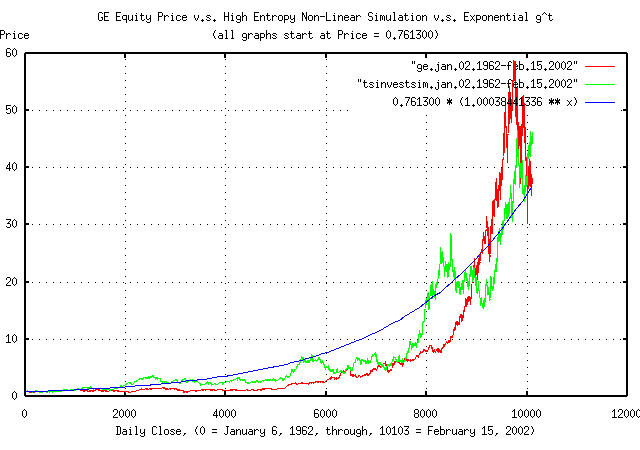
|
From: John Conover <john@email.johncon.com>
Subject: Quantitative Analysis of Non-Linear High Entropy Economic Systems I
Date: 14 Feb 2002 07:38:46 -0000
Much of applied economics has to address non-linear high entropy systems-those systems characterized by random fluctuations over time-such as equity prices, gross domestic product, industrial markets, etc.
An optimal wagering strategy for high entropy systems was first suggested by Claude Shannon in the mid 1940's in his pioneering work on information theory, The Mathematical Theory of Communication, (pp. 39-42.) The concept was further refined by J. L. Kelly Jr. in the Bell System Tech. J. vol. 35, 1956, A New Interpretation of Information Rate, (pp. 917-926), which established the isomorphism between the information-theoretic concept of information rate in a binary symmetric channel and speculation under uncertainty. More recently, Fazlollah M. Reza in An Introduction To Information Theory, (pp. 450-452,) has offered an alternative derivation that requires only the concepts of the law of large numbers, and the maxima from calculus-both taught in freshman mathematics-to derive the same optimal wagering strategy.
Note: the C source code to all programs used are available from the NtropiX Utilities page, or, the NdustriX Utilities page, and are distributed under License.
Following Reza, suppose a gambler wagers on an iterated game of
chance. Further, suppose there is a chance,
P, of the gambler winning any iteration
of the game, and of 1 - P, of
losing. Let the capital the gambler starts with be
V(0), and
V(t) the capital after the
t'th iteration of the game. Since the
gambler is not certain of the outcome of any iteration of the game,
only a fraction, f, of the capital is
wagered on each iteration of the game. Thus, after
t many iterations the capital is:
w l
V(t) = (1 + f) * (1 - f) * V(0) ..................(1.1)
where w is the number of times the
gambler won, and l = t - w, the number
of times the gambler lost. These numbers are functions of two random
variables, denoted by W and
L. Then, by the law of large
numbers:
1
lim - W = P .............................(1.2)
t->infinity t
1
lim - L = q = 1 - P .....................(1.3)
t->infinity t
The gambler must determine the fraction,
f, of the capital to wager on each
iteration of the game, which will maximize the average exponential
growth rate, G, of the capital, i.e.,
maximize the value of:
1 V(t)
G = lim - ln (----) .....................(1.4)
t->infinity t V(0)
with respect to f:
W L
G = lim - ln (1 + f) + - ln (1 - f) .....(1.5)
t->infinity t t
G = P ln (1 + f) + q ln (1 - f) ....................(1.6)
which, by taking the derivative with respect to
f, and equating to zero, is maximal
when:
dG P - 1 1 - P
-- = P (1 + f) (1 - f)
df
1 - P - 1 P
- (1 - P) (1 + f) = 0 ................(1.7)
and, combining terms:
P - 1 1 - P
P (1 + f) (1 - f)
P P
- (1 - P) (1 - f) (1 + f) = 0 ................(1.8)
and, splitting:
P - 1 1 - P
P (1 + f) (1 - f)
P P
= (1 - P) (1 - f) (1 + f) ....................(1.9)
Taking the logarithm of both sides:
ln (P) + (P - 1) ln (1 + f) + (1 - P) ln (1 - f)
= ln (1 - P) - P ln (1 - f) + P ln (1 + f) .....(1.10)
and combining terms:
(P - 1) ln (1 + f) - P (ln (1 + f) + (1 - P) ln (1 - f)
+ P ln (1 - f) = ln (1 - P) - ln (P) ...........(1.11)
or:
ln (1 - f) - ln (1 + f) = ln (1 - P) - ln (P) ......(1.12)
and performing the logarithmic operations:
1 - f 1 - P
ln (-----) = ln (-----) ............................(1.13)
1 + f P
and exponentiating:
1 - f 1 - P
----- = ----- ......................................(1.14)
1 + f P
reduces to:
P (1 - f) = (1 - P)(1 + f) .........................(1.15)
and expanding:
P - P f = 1 - P f - P + f ..........................(1.16)
or:
P = 1 - P + f ......................................(1.17)
and, finally:
f = 2 P - 1 ........................................(1.18)
Substituting, q, from Equation
(1.3) into Equation
(1.6):
G = P ln (1 + f) + (1 - P) ln (1 - f) ..............(1.19)
where G is
the average exponential growth rate of the gambler's capital, per
iteration of the game. As a useful form, exponentiating both
sides:
P (1 - P) G
g = (1 + f) (1 - f) = e ...................(1.20)
where the gain, g, is the average
multiplicative gain per iteration of the game, i.e., after
t many iterations, the gambler's capital
would have increased by a factor of
g^t.
|
As a side bar, if For the initiated, the equations can be derived using Ito
Calculus, which is the preferred methodology in Geometric
Brownian Motion analysis. From Ito's
Lemma, then the average, Which has the interesting implication, for the sum of many Geometric Brownian Motion trajectories, (for example, a portfolio, or GDP,) that the sum is not ergodic, in the sense of the time-average of the sum not being equal to the ensemble average, (the ensemble having a Log Normal distribution.) |
Equation
(1.18) and Equation
(1.20) are important. As a simple example, suppose each outcome of
an iterated game depends on a throw of a fair six sided die-if the die
comes up four, or less, the gambler wins what was wagered; else loses
it. The gambler's optimal strategy is to put 1 /
3 of the capital at risk, (by wagering it,) on each
iteration of the game, since P = 4 / 6,
and from Equation
(1.18), f = 2 P - 1 = 1 / 3. The
gambler's capital would increase, from Equation
(1.20), on average, by a factor of g =
1.05826736798 per iteration of the game, or about
6% per game.
But how does the gambler play the game if the value for P is unknown?
Equation (1.20) offers a metric methodology. For the
t'th iteration of the game, the
fractional gain, f(t), in the gambler's
capital for the iteration is:
V(t) - V(t - 1)
f(t) = --------------- .............................(1.21)
V(t - 1)
The absolute value of f(t) is the
fraction of the capital the gambler wagered on the
t'th iteration of the game-it is the
fraction of capital that the gambler put at risk,
f. The capital increased if the gambler
won on the game in the t'th iteration,
and decreased if the gambler lost-by the fraction of the capital the
gambler put at risk, f.
|
As a side bar, this is one of the fundamental concepts in the
quantitative analysis of high entropy economic systems-risk is
the root-mean-square, This presents a definition issue for the term root-mean-square:
The term root-mean-square is used here in the engineering or
physics sense of noise power from electronic
communication theory; instantaneous power depends on the
absolute value of a quantity, (like
There is a potential conflict of definition between this
derivation and the concept of (implicit,) risk = statistical
root-mean-square, For the initiated, the running average of the marginal
increments, |
If n has a sufficiently
large data set size, then by the law of large numbers, in
n many iterations of the game, the total
number of wins for the gambler would be expected to be n
P and the total number of losses would be expected to
be n (1 - P), for an average number of
wins of (n P - n (1 - P)) / n = 2 P -
1. The average gain, avg
would then be:
avg = (2 P - 1) f ..................................(1.22)
where f is the return on the fraction
of capital wagered on each iteration of the game,
(srms,) and is equal to
rms, the root-mean-square of the
marginal increments of the capital, and
avg is the mean of the marginal
increments of the capital. Solving for
P:
avg
--- = 2 P - 1 ......................................(1.23)
rms
avg
--- + 1
rms
P = ------- ........................................(1.24)
2
The interpretation of P is that it is
the likelihood of up movement in the characteristics of a high entropy
economic system.
Substituting Equation
(1.18) for P in Equation
(1.24), and letting f = rms:
avg
---- + 1
rms + 1 rms
------- = -------- ................................(1.25)
2 2
or, maximal growth occurs when:
2
avg = rms .........................................(1.26)
|
As a side bar, note that the entropic model used is non-linear; it is not a random walk model. A random walk is a cumulative sum of a random variable-the noise is additive. In the entropic model used, the noise is multiplicative. The long term characteristics of the model exhibit a log-normal distribution, as mentioned in Section II. As an equivalent model, the iterative equation: can be used, where Note the similarity to the simplist non-linear dynamical system function, the iterated parabolic/logistic function: The paradigm of the model is that the higher order terms, (of which their may be many,) of the economic non-linear dynamical system can be modeled with a high entropy stochastic methodology-if the complexity of the economic system is sufficiently high. A concept not unlike pertubation theory. |
The concept is similar to automating risk
arbitrage, based on historical performance, where an
expected-value table of the difference between an
investment's potential upside, (multiplied by the probability
of achieving the potential upside,) and the the potential
downside, (multiplied by the probability of the downside
occurring,) is the expected value of the return of the
investment-the difference between the potential upside and potential
downside corresponding to the root-mean-square,
rms, of the value of the investment, and
the average, avg, the expected value,
where P is the likelihood of the
potential upside occurring.
Reiterating the important equations for high entropy economic systems:
avg
--- + 1
rms
P = ------- ........................................(1.24)
2
P (1 - P)
g = (1 + rms) (1 - rms) ....................(1.20)
and for maximal growth:
rms = 2 P - 1 ......................................(1.18)
which is when:
2
avg = rms .........................................(1.26)
where avg is the mean, and
rms the root-mean-squre, of the system's
marginal increments.
Of interest is that only two
variables,avg and
rms, are involved in optimizing the
performance of a high entropy economic system. Typical values for
avg and
rms are
0.0004 and
0.02, respectively, for daily
data. P would then have a value of
0.51, and
g a value of
1.0002 per day, which is about
5% per calendar year, for
253 business days in a calendar
year.
As an emperical exercise to demonstrate the usage of Equation
(1.24) and Equation
(1.20), the equity price history for General Electric, (ticker
symbol, GE,) for the last 10,103 days, (January 4, 1962, to February
15, 2002,) was downloaded from Yahoo!'s Historical Prices database, and
the csv2tsinvest
program used to convert the database to a time series. The mean of the
marginal increments of the price, avg,
and the root-mean-square of the price,
rms, was found to be
0.000499, and
0.015145, respectively, using the
tsfraction,
tsavg,
and, tsrms
programs. On January 4, 1962, the initial value of the equity was
$0.761300, adjusted for splits. On
February 15, 2002, the value was
$37.11.
From Equation (1.24):
0.000499
-------- + 1
0.015145
P = ------------ = 0.516474084 .....................(1.29)
2
And, from Equation (1.20):
0.516474084
g = (1 + 0.015145) *
(1 - 0.516474084)
(1 - 0.015145)
= 1.00779357225 * 0.992648138
= 1.00038441336 ..................................(1.30)

|
Figure I is a plot of the GE's equity price, from January 4, 1962,
to February 15, 2002, and the equation 0.761300 *
1.00038441336^t. Additionally, the tsinvestsim
program was used to generate a time series with the same
characteristics, (P = 0.516474084,
I = 0.761300, and f =
0.015145,) using a uniformly distributed random number
generator, to produce a binomial frequency distribution with 10103
elements to simulate a normal/Gaussian distribution, which is
overlayed, also.
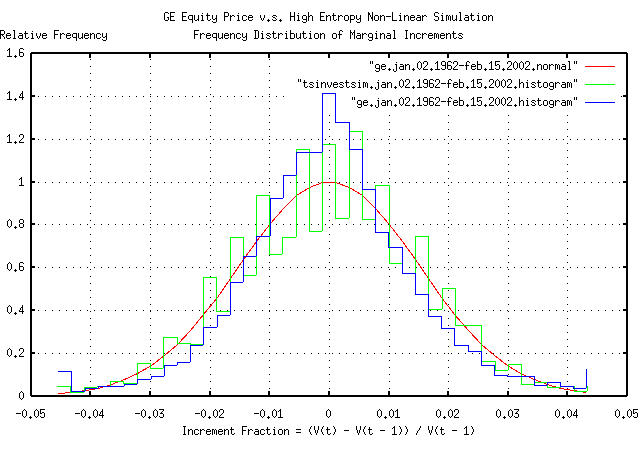
|
Figure II is the frequency distribution of the marginal increments
of GE's equity price, from January 4, 1962, to February 15, 2002, and
a least squares fit of the distribution to a Normal/Gaussian bell
curve distribution. The binomial frequency distribution of the
marginal increments of the time series simulated with the
tsinvestsim
program shown in Figure I is also displayed. The data in Figure II was
made with the tsnormal
program. The comb effect in the binomial frequency
distribution was caused by aliasing between the binomial elements in
the frequency distribution and the histogram element size of the plot,
and could be removed by choosing a larger histogram element size. Of
passing interest is the leptokurtosis in the frequency distribution of
the marginal increments of GE's equity price, which is explored
further in Example
III.
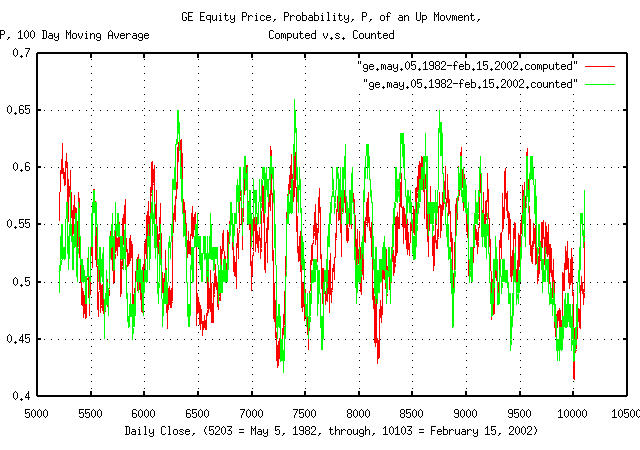
|
Figure III is a plot of the likelihood,
P, of an up movement in GE's equity
price as computed by the tsshannonwindow
program for a 100 day moving window, from May 5, 1981 to February 15,
2002-4,900 business days for clarity. The first time series presents
likelihood, P, computed by Equation
(1.24) for the moving window. The second by counting the number of
up movements in the window.
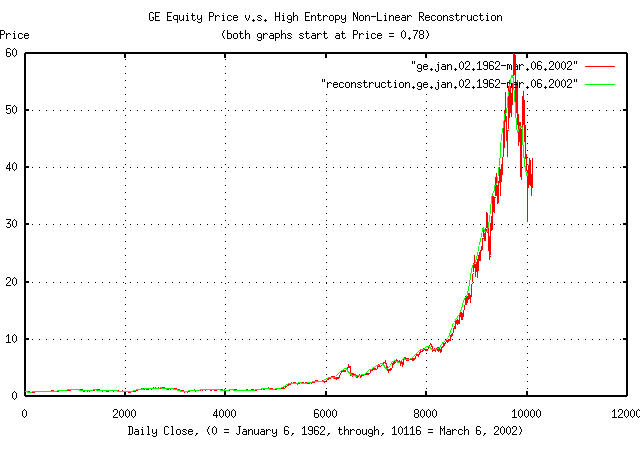
|
Figure IV is a plot of the reconstructed GE equity price time
series, as computed by the tsgainwindow
program for a 100 day moving window, from January 6, 1962 to March 6,
2002, overlayed on the original GE equity price. The tsgainwindow
program uses Equation
(1.24) and Equation
(1.20) to derive the statistics of the time series for the moving
window, which is then used for the reconstruction:
tsgainwindow -w 100 ge.jan.02.1962-mar.06.2002 | tsmath -l | tsintegrate | \
tsmath -e | tsmath -m 0.78 > reconstruction.ge.jan.02.1962-mar.06.2002
where "tsmath
-l | tsintegrate
| tsmath
-e | tsmath
-m 0.78" implements the geometric
reconstruction by taking the natural logarithm of the series,
integrating it, exponentiating it, and scaling it by a factor of 0.78,
which was the initial value of the original time series.
If the component companies in the DJIA are the premier companies in the US exchanges, then their equity price characteristics should be near optimally maximal, i.e., consistent with Equation (1.26).
| Symbol | Name | avg |
rms |
rms^2 |
|---|---|---|---|---|
AA |
Alcoa |
0.000510 |
0.020365 |
0.000415 |
AXP |
American Express |
0.000538 |
0.021724 |
0.000472 |
BA |
Boeing |
0.000493 |
0.024889 |
0.000619 |
C |
CitiGroup |
0.000405 |
0.022257 |
0.000495 |
CAT |
Caterpillar |
0.000423 |
0.019186 |
0.000368 |
DD |
Du Pont |
0.000331 |
0.017290 |
0.000299 |
DIS |
Disney |
0.000919 |
0.025126 |
0.000631 |
EK |
Eastman Kodak |
0.000338 |
0.028620 |
0.000819 |
GE |
General Electric |
0.000512 |
0.015452 |
0.000239 |
GM |
General Motors |
0.000257 |
0.017700 |
0.000313 |
HD |
Home Depot |
0.000818 |
0.027398 |
0.000751 |
HON |
Honeywell |
0.000438 |
0.020541 |
0.000422 |
HWP |
Hewlett-Packard |
0.001378 |
0.051051 |
0.002606 |
IBM |
International Business Machines |
0.000321 |
0.016877 |
0.000285 |
INTC |
Intel |
0.001406 |
0.028905 |
0.000835 |
IP |
International Paper |
0.000359 |
0.018274 |
0.000334 |
JNJ |
Johnson & Johnson |
0.000703 |
0.016049 |
0.000258 |
JPM |
JP Morgan Bank |
0.000375 |
0.023279 |
0.000542 |
KO |
Coca Cola |
0.000534 |
0.016808 |
0.000283 |
MCD |
McDonalds |
0.000506 |
0.020492 |
0.000420 |
MMM |
Minnesota Mining and Manufacturing (3M) |
0.000378 |
0.014766 |
0.000218 |
MO |
Philip Morris |
0.000770 |
0.017934 |
0.000322 |
MRK |
Merck |
0.000583 |
0.015963 |
0.000255 |
MSFT |
Microsoft |
0.001593 |
0.026458 |
0.000700 |
PG |
Procter and Gamble |
0.000515 |
0.015394 |
0.000237 |
SBC |
SBC Communications |
0.000597 |
0.016261 |
0.000264 |
T |
AT&T |
0.000113 |
0.022534 |
0.000508 |
UTX |
United Technologies |
0.000588 |
0.018409 |
0.000339 |
WMT |
WalMart Stores |
0.001507 |
0.034505 |
0.001191 |
XOM |
Exxon Mobil |
0.000479 |
0.013938 |
0.000194 |
TABLE I contains the average, avg,
the root-mean-square, rms, and the
root-mean-square, squared, rms^2, of the
marginal increments for the equity price time series for each of the
component companies in the DJIA. The daily close equity price history
for each component company in the DJIA was downloaded from Yahoo!'s Historical Prices database, and
the csv2tsinvest
program used to convert the database to a time series. The
tsfraction,
tsavg,
and, tsrms
programs were used to calculate the average,
avg, and, the root-mean-square,
rms, of the marginal increments of each
time series. The tsmath
program was used to square the rms
values. The time series files represented from between January 2, 1962
and July 9, 1986 for the various component companies, to March 6, 2002.
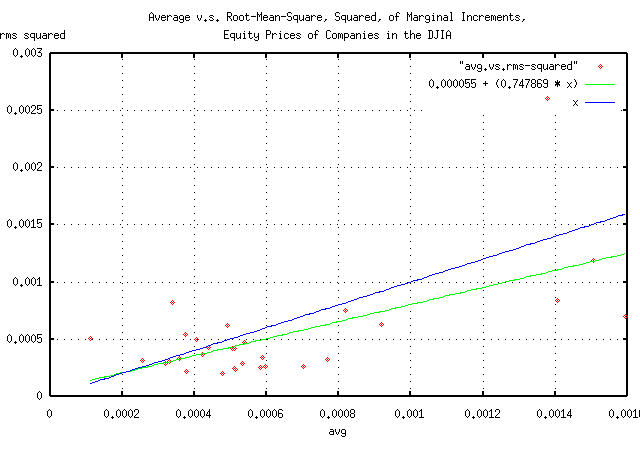
|
Figure V is a parametric scatter plot of the average v.s. the
root-mean-square, squared, avg and
rms^2, respectively, of the component
companies of the DJIA. The figure is a pictographic representation of
the data in TABLE I.
It does, indeed, appear that the equity price growth of most of the DJIA component companies is near optimally maximal, although slightly risk adverse.
The historical time series of the DJIA's 27949 daily closes, from
January 2, 1900 through March 6, 2002, inclusive, was obtained from Yahoo!'s database of equity Historical Prices, (ticker symbol
^DJI,) in csv format. The csv format was
converted to a Unix database format using the csv2tsinvest
program, filename
djia1900-2002, and files of the
marginal increments of the DJIA made:
tsfraction djia1900-2002 | tsnormal -t > djia.1900.jan.02-2002.mar.06
tsfraction djia1900-2002 | tsnormal -t -f > djia.1900.jan.02-2002.mar.06.histogram
From Figure
IV, the average and root-mean-square values, avg =
0.0004, and, rms = 0.02,
respectively, seem reasonable approximations for the median values for
the marginal increments of the equities in the DJIA. Additionally, the
instantaneous values of the equities in the DJIA seem to have a, from
Section
II, a log-normal distribution with a range that is, approximately,
an order of magnitude and a half. As a simple simulation of the DJIA,
the tsinvestsim
program can be used with the data
file:
tsinvestsim -n 1000 data 27949 | tsinvest -i -j | cut -f1 | \
tsfraction | tsnormal -t > tsinvestsim.jan.02.1900-mar.06.2002
tsinvestsim -n 1000 data 27949 | tsinvest -i -j | cut -f1 | \
tsfraction | tsnormal -t -f > tsinvestsim.jan.02.1900-mar.06.2002.histogram
and the files plotted:
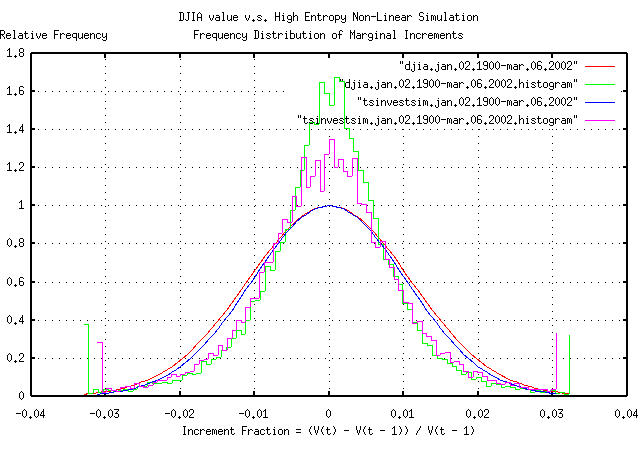
|
Figure VI is the frequency distribution of the marginal increments
of the DJIA's value, from January 2, 1900, to March 6, 2002, and a
least squares fit of the distribution to a Normal/Gaussian bell curve
distribution. The binomial frequency distribution of the marginal
increments of the time series simulated with the tsinvestsim
program. The data in Figure VI was made with the tsnormal
program.
|
As a side bar, Figure VI is interesting-the simulation was made using a binomial process, which produces normal/Gaussian distributions. The evolution of a geometric progression of a random variable with a normal/Gaussian distribution is a log-normal distribution. What happens is that the price distribution of the 30 equities in the DJIA evolves into a log-normal distribution, with one equity dominating the index value at all times; its price fluctuations dominate the fluctuations in the index, too. The contribution of the marginal increments of the other 29 equities contribute less to the index's fluctuations. So, it would be expected that an index, made up of the sum of equities from a geometric process, with price fluctuations that have a normal/Gaussian distribution, would have a bell curve that is pushed up around the mean with fat tails-exactly what is shown in Figure VI. (As a modeling exercise, slightly exponentiating normal/Gaussian distributed increments will simulate leptokurtosis, too.) Most economic time series exhibit such phenomena, and because of the importance, log-normal distributions will be discussed in Section II in some detail. Note that leptokurosis means higher risk; the tails contain
too much of the distribution and the root-mean-square,
In some sense, the long term objective of portfolio management is to minimize leptokurtosis in the increments of the portfolio's value; portfolios with leptokurtotic distributions of the increments gain fabulous wealth quite quickly, only to to lose it all when the risk asserts itself-a portfolio with leptokurtotic distribution of the increments can not remain a fugitive from the laws of probability forever. (Its why investing in indices is probably not such a good idea, and why the dot-com valuations came down so fast, too-the dot-com companies were notorious for having leptokurtotic distributed price fluctuations.) (Just so there is no confusion, Figure VI does not represent a log-normal distribution-it represents the sum of geometric processes that evolves into a log-normal distribution. Equity prices evolve into log-normal distributions, with, approximately, normal/Gaussian distributed increments; indices are the sum of equity prices, and have non-Gaussian distributed increments, i.e., distributions with fat tails, or leptokurtosis. As a final qualification, the amount of leptokurtosis is not stable, or constant over time-the long term evolution of indices with log-normal distributions of the constituent parts is for one part to totally dominate the index, and, in the long term, the marginal increments of the index will have the normal/Gaussian distribution of that part.) |
It has been suggested that the leptokurtosis in economic time series is created by the fractal dimension of the data not being 2- which is the value for a simple Brownian motion fractal-and persistence, (i.e., a slight tendency for the next movement in the time series to be like the last.) But there can be other reasoning, too.
tsmath -l djia1900-2002 | tslsq -o | tsroot -l | \
tsscalederivative > djia.1900.jan.02-2002.mar.06
tsinvestsim -n 1000 data 28048 | tsmath -l | tslsq -o | tsroot -l | \
tsscalederivative > tsinvestsim.jan.02.1900-mar.06.2002
where the data
file is the same as used for Figure
VI, above.
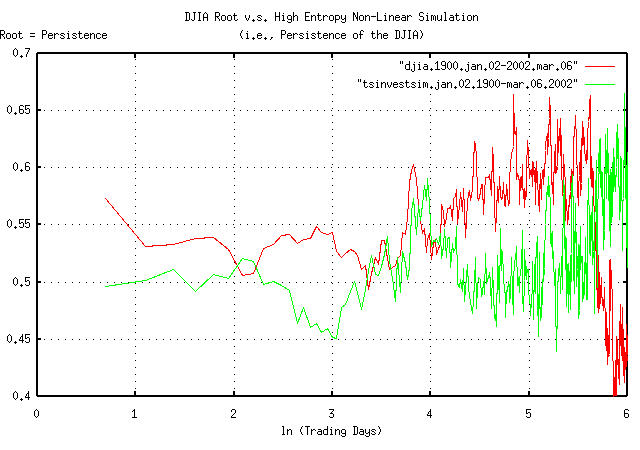
|
Figure VII is a plot of the persistence, (sometimes called the Hurst Exponent from rescaled range analysis, Range/Scale,) of the DJIA, and a simulation with similar statistics. Of interest is the variability of the persistence-it is far from constant over time, which would be expected in a well behaved fractal. Some observations:
The persistence of the DJIA at e^0.693147 =
1 day is 0.573078, and
then falls rapidly-this is a contradiction with the Efficient
Market Hypothesis, (EMH), which predicates that the market
responds to information instantaneously; the contradiction is not
serious for most analysis, and the approximation used in the EMH is
probably reasonable for general purposes, (all it says is that an
instantaneous market response to new information means
within a few days.)
At about e^2.2 = 9 days, the
persistence drops to just over 0.5.
And then the persistence raises to about 0.6 through the rest
of a calendar year, (of about 253 trading days in a calendar year,
or at ln (253) = 5.5, when it, quite
quickly, goes anti-persistent.
Although such variability in persistence could be attributed to Non-Linear Dynamical System, (NLDS,) dynamics, it is more likely a structural artifact. For example, the anomaly could be created by a downtrend, followed by an uptrend about 30 trading days later, on average, that happens, on average, about once a year, (in addition to the short term few day inefficiency.) Looking at the time series of the DJIA, October and November frequently have about a month and a half downward spike, which also happens to correspond with October 31, the time that mutual fund capital and income gains taxation liabilities are executed at the end of the fiscal year, as mandated under US Federal law, (usually, resulting in mutual fund companies holding a fire sale on equities they hold with bad pro forma.) Note, also, that many NLDS methodologies would indicate that structural phenomena are system dynamics-leading to inappropriate interpretations of the data.
However, using an average persistence of
0.57 for the DJIA, (and its constituent
equities, too,) can adequately model the NLDS/structural
phenomena. This means that the root-mean-square of the marginal
increments, rms, would not be added as
((1 / n) * sum increment^2)^0.5, but as
((1 / n) * sum increment^(1 /
0.57))^0.57. (For an example of the consequences of
assuming that risk is represented as the root-mean-square of the
marginal increments, see the section on the DJIA,
from Section
III.
Of passing interest is the fact that, as shown in Figure VII, the simulation showed substantial leptokurtosis, but no persistence.
As a approximation for non-linear high entropy economic system's
daily data, from Equation
(1.20), the exponential marginal gain per unit time,
g, will typically be about
1.0002, and the ln
(1.0002) will be about
0.0002. The average of the time series'
marginal increments, avg, that has
exponential marginal gain per unit time, g =
1.0002 will be about
0.0004. So, as an approximation, divide
the avg by two, and that's the
ln (g); add unity to get
g.
If a non-linear high entropy economic system is assummed to be operating near optimality-a reasonable assumption for most economic systems-then substituting Equation (1.26) into Equation (1.24):
avg
---- + 1
rms rms + 1 sqrt (avg) + 1
-------- = ------- = -------------- ...............(1.31)
2 2 2
-- John Conover, john@email.johncon.com, http://www.johncon.com/